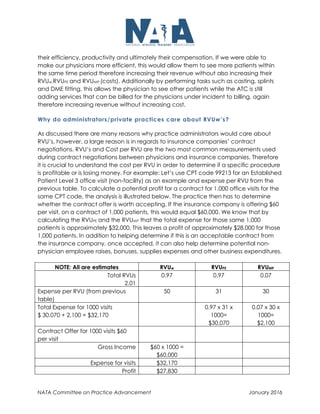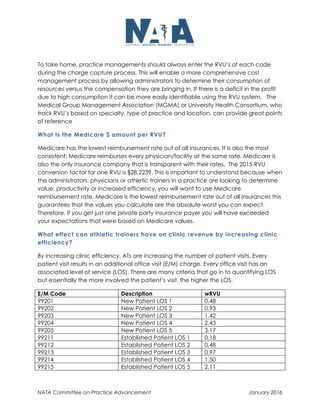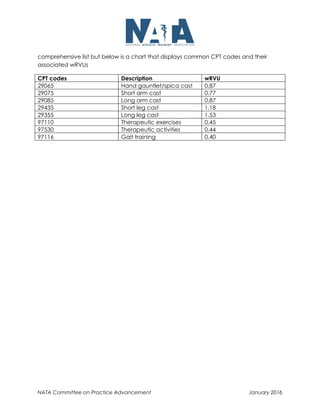This document discusses Relative Value Units (RVUs), which are a standard measurement of cost used by Medicare and other payers. RVUs measure the resources consumed during medical procedures and practices can use RVUs to track expenses, revenues, and determine costs per procedure. By increasing efficiency and patient volumes, athletic trainers in physician practices can help generate more RVUs and downstream revenues through additional office visits, injections, surgeries, and other services.

![NATA Committee on Practice Advancement January 2016
RVUMP) for each CPT code on a spreadsheet. This allows the practice to calculate dollar
value for each component of the RVU by dividing total expenses for each of the three
RVU categories.
What is the difference between total, work and facility RVU’s?
The RBRVS reimbursement schedule assigns certain values to procedures based on Total
RVU’s. The total RVU consists of three separate components: work (RVUw), practice
expense (RVUPE) and malpractice (RVUMP). The main component of total RVU is
RVUw and accounts for 50-55% of the total RVU. The RVUw is comprised of two separate
components: time (approximately 70%) and effort (approximately 30%). Time is
calculated by the time spent before, during and after providing a service, such as
charting or dictating. Similarly, the effort consists of the physical effort, skill and stress
involved with providing that service. The more complex a medical problem, the higher
the RVUw.
The RVUPE, the next major component of total RVU, accounts for 40-45% of the total RVU
formula. This includes all non-physician and administrative payroll and benefits, office
expenses, medical supplies, equipment and miscellaneous expenses such as
accounting and legal. Medicare has gathered information by prior year surveys and,
after calculating per hour cost, modifies this portion of the RVU for each specialty as
well as for the type of facility.
Furthermore, Medicare adjusts payments by designating a geographic price cost index
or GPCI and pays differently for the same procedure depending on where the practice
is located. Additionally important is the Conversion Factor (CF), which converts the RVU
into a charge and reimbursement. The CMS Medicare CF for 2015 is $28.2239. The
payment formula is:
[(RVUw x work GPCI) + (RVUPE x PE GPCI) + (RVUMP x malpractice GPCI)] x CF for the year
in question.
Why do physicians care about RVUws?
RVUw are commonly used to measure a physician’s productivity & compensation. Each
physician’s productivity is measured by the sum of Total RVU’s recorded for each CPT
code multiplied by the CF, which gives the practice reimbursement for each CPT code.
Why do athletic trainers care about RVUws?
Since physicians often rely on their RVUw to determine their compensation, it is vital to
our position as an athletic trainer working in a physician practice to help them increase](https://image.slidesharecdn.com/c87a5a08-0529-49da-8205-b5a0555c529b-160125174531/85/Relative-Value-Units-Athletic-Trainers-2-320.jpg)



